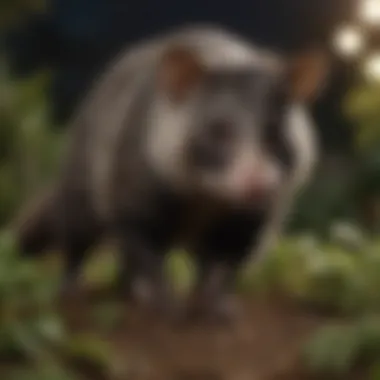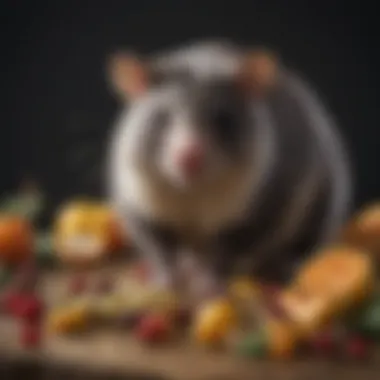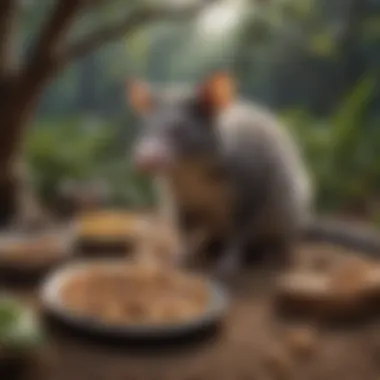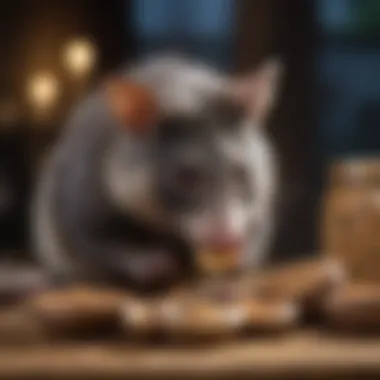Understanding Possum Food: Diet, Preferences, and Feeding Habits


Intro
Possums are often overlooked in the discussion of wildlife, yet they play a crucial role in their ecosystems. Understanding their food preferences, dietary habits, and feeding behavior is key to grasping their ecological significance. In this section, we will delve into the specifics of possum nutrition, the natural and urban environments they navigate, as well as their interaction with their habitat.
Animal Overview
Common Name and Scientific Classification
Possums belong to several species within the order Diprotodontia. The most recognized species is the Virginia opossum (Didelphis virginiana), native to North America. While many refer to them simply as possums, it is important to note that the term can encompass various marsupials in the suborder Phalangeriformes, found primarily in Australia and New Guinea.
Physical Characteristics
Possums display a range of physical attributes. On average, they are small to medium-sized marsupials, with a body length of around 30 to 100 centimeters. They have a pointed snout, long tail, and fur that varies significantly from grey to brown. Their prehensile tail allows for better tree navigation, which is crucial for foraging and escaping predators.
Habitat and Distribution
Possums thrive in diverse habitats, ranging from tropical rainforests to suburban areas. They are adaptable creatures. Their distribution extends from the eastern United States through Central America. In Australia, different species like the brushtail possum (Trichosurus vulpecula) inhabit eucalyptus forests and urban settings alike.
Behavior and Social Structure
Communication Methods
Possums utilize vocalizations, body language, and scent marking to communicate. These methods are crucial for establishing territory and finding mates. Their nocturnal nature means much of their communication occurs in the cover of night, often making it subtle but effective.
Social Hierarchies
While possums are generally solitary animals, they exhibit a loose social structure that can include overlapping territories. They may share space in urban environments, leading to a hierarchical arrangement where dominant individuals secure better access to food sources.
Mating and Reproductive Behavior
Mating season usually occurs during the warmer months. Female possums can have two litters per year, each consisting of two to eight young. After a gestation period of about 12 days, the underdeveloped young crawl into the mother’s pouch for continued growth. This reproductive strategy helps ensure the survival of the species in varying environmental conditions.
Conservation Status
Current Population Trends
Possum populations fluctuate depending on their habitat and environmental pressures. Urban areas often see stable populations due to available food sources but face challenges such as vehicle collisions and habitat disruption.
Threats and Challenges
Habitat loss due to urbanization and agriculture poses the most significant threat to possums. Additionally, diseases such as toxoplasmosis can affect their survival rates. Conservation efforts are essential to understand and mitigate these impacts.
Conservation Efforts and Success Stories
Various groups work tirelessly to promote possum conservation. Educating the public about the ecological role of possums helps foster a more harmonious relationship between humans and wildlife. Initiatives that protect their natural habitats, alongside urban feeding guidelines, can contribute to the sustainable coexistence of possums in urban settings.
Possums are integral to their ecosystems, aiding in seed dispersal and pest control, making them vital partners in ecological balance.
This exploration of possum biology not only enhances our understanding of their diets but also emphasizes the importance of responsible interaction with these unique animals.
Foreword to Possums
Possums are fascinating creatures that play a vital role in their ecosystems. Understanding their behavior, especially their feeding habits, is essential. They are unique marsupials, with diets that reflect their adaptability to different environments. This section introduces possums, laying the groundwork for a more detailed exploration of their diets, preferences, and feeding habits.


Taxonomy and Species Overview
Possums belong to the order Diprotodontia, which includes other marsupials like kangaroos and koalas. Within this order, they are classified under the suborder Phalangeroidea. The term 'possum' can refer to several species. The most common ones include the Common Brushtail Possum, the Sugar Glider, and the Eastern Grey Possum.
Each species has its own dietary preferences and ecological roles. The Common Brushtail Possum, for example, is known for its adaptability and omnivorous diet. Meanwhile, the Sugar Glider relies heavily on a varied diet of nectar, fruits, and insects. Understanding these differences is crucial for grasping their ecological impact.
Natural Habitat and Range
Possums thrive in a variety of habitats. They are found in urban areas, forests, and woodlands across Australia and nearby regions. Their range extends from coastal regions to inland forests, adapting to both temperate and tropical climates.
These marsupials are nocturnal, which helps them avoid predators. Their natural habitat provides not only shelter but also a diverse food source. For example, urban areas often present a different set of challenges and food options compared to wild environments. The adaptability of possums makes them a vital part of both habitats.
Understanding their habitat and range is vital for conservation efforts. The environment directly impacts their diet and feeding habits. Therefore, knowing where possums live can inform better practices for preserving their populations.
General Diet of Possums
The study of possum diets is fundamental to understanding their biology and ecology. Possums play a unique role in their habitats. Their feeding behavior influences both their health and the ecosystems they inhabit. Understanding what possums eat helps in making informed choices about conservation efforts. Moreover, knowing their diet assists those who may interact with them in urban settings, promoting responsible practices.
Omnivorous Nature
Possums are omnivorous creatures. This aspect of their diet allows them to exploit a range of food sources. They can thrive in varied environments due to their flexibility in feeding. Being omnivores means they consume both plant-based and animal-based foods. This adaptability contributes to their resilience in fluctuating habitats. They do not rely on a single food type, which provides a significant survival advantage.
Common Food Sources
Possums have diverse dietary preferences, which can be categorized into three main groups: fruits and berries, vegetation and leaves, and insects and small animals.
Fruits and Berries
Fruits and berries are a prominent part of a possum's diet. These foods contain essential sugars and vitamins, making them a preferred choice. Possums are often drawn to ripe fruits due to their high energy content. This preference supports their nocturnal lifestyle, providing necessary calories for nighttime activities.
One unique feature of fruits and berries is their seasonal availability. This factor can influence possum behavior, with feeding habits varying throughout the year. While fruits offer many benefits, they should be consumed in moderation. An over-reliance on sugary fruits could lead to health issues. Therefore, it is important for possums to have a balanced diet that includes other food sources.
Vegetation and Leaves
Vegetation and leaves represent another essential food category. These items provide fiber and various nutrients that support digestion and overall health. Possums often feed on the leaves of trees and shrubs, offering diversity in their diet.
The key characteristic of vegetation is its stability within the habitat year-round. Unlike fruits, leaves are present regardless of the season. This availability ensures possums have a consistent food source. However, dietary strategies must consider that not all vegetation is equally nutritious. Some leaves may be less palatable or contain toxic compounds. Thus, possums must have the knowledge to choose their food wisely to avoid any adverse effects.
Insects and Small Animals
Insects and small animals complete the possum diet. These food items provide high protein content, which is crucial for growth and reproduction. Possums exhibit remarkable adaptability in hunting and foraging for these protein sources.
The key aspect of insects and small animals is their nutrient density. They contribute significantly to the overall diet, particularly when other food sources are scarce. However, catching prey requires energy and skill, which can be a limitation in some environments. Possums that rely heavily on this food source must ensure their energy needs are met through other dietary components.
Understanding the general diet of possums reveals their ecological role and adaptability. This knowledge can guide conservation efforts and interactions with these unique marsupials.
Nutritional Requirements
Nutritional requirements are critical for possums, as these factors dictate their overall health and wellbeing. Possums, being omnivorous marsupials, require a balanced diet that includes a variety of nutrients. A proper mix of vitamins, minerals, proteins, and carbohydrates plays a significant role in their growth, reproduction, and immune system function. Their diet not only affects their physical health but also their behavior and longevity.
Ensuring that possums receive adequate nutrition is essential for keeping wild populations stable and fostering their survival in urban environments. This section will delve into the vitamins and minerals that are vital for possum health, alongside the repercussions of dietary deficiencies.
Vitamins and Minerals Essential for Health
Possums obtain essential vitamins and minerals primarily through their natural diet, which varies by region and availability of food sources. Some crucial vitamins include:


- Vitamin A: Important for vision and immune function. It is commonly found in leafy greens and some fruits.
- Vitamin D: Assists in calcium absorption and bone health. Possums may synthesize vitamin D through sunlight exposure or obtain it from specific food sources.
- B Vitamins: These vitamins support metabolism and energy production. Foods high in B vitamins include fruits like bananas and avocados, as well as nuts.
Minerals are equally important:
- Calcium: Critical for bone strength and muscle function. Possums acquire calcium from plant-based foods, particularly from leafy greens and fruits.
- Phosphorus: Works closely with calcium to maintain bone health.
- Iron: Necessary for oxygen transport in the blood. Possums can obtain iron from insects and certain plant materials.
Maintaining a balanced intake of these nutrients is vital for ensuring that possums can thrive in both wild and urban settings.
Impact of Diet on Possum Health
The dietary habits of possums have profound effects on their health. A well-rounded diet promotes longevity and vitality, while a lack of essential nutrients can lead to various health concerns.
Some of the impacts that diet can have include:
- Poor Immune Function: Insufficient vitamin and mineral intake can weaken a possum's immune system. This makes them more susceptible to diseases and infections.
- Reproductive Health Issues: Nutrient deficiencies can affect reproductive success in possums. For example, a lack of certain vitamins is linked to lower fertility rates.
- Growth and Development Problems: Young possums that do not receive adequate nutrition may experience stunted growth or developmental problems. This can affect their survival rates in the wild.
“The health of possums is inextricably linked to their diet, highlighting the importance of understanding their nutritional requirements.”
Feeding Behavior
Understanding possum feeding behavior is crucial for comprehending their ecological role and how they interact with their environments. This section will delve into the specific foraging techniques and seasonal variations in diet that characterize possums, giving insights into how these nocturnal marsupials adapt to the changing conditions of their habitats. Knowing these behaviors allows us to implement better strategies for conservation and responsible interaction.
Foraging Techniques
Possums are naturally adept at foraging, which is a significant behavior for their survival. They have evolved to maximize their food intake by employing various techniques. One well-known technique is their ability to explore different levels of vegetation. Possums often climb trees and shrubs, allowing access to fruits and leaves that other ground-wise animals might miss. They use their sensitive whiskers to detect changes in their immediate environment, helping them locate food sources more efficiently.
In urban areas, possums have adapted to human presence, frequently scavenging for leftovers. Their omnivorous diets are complemented by this behavior, enabling them to survive in conditions where natural food might be scarce. Some effective foraging strategies include:
- Scavenging: Searching through trash bins for discarded food.
- Browsing: Grazing on low vegetation at night.
- Climbing: Ascending trees to reach fruits and flowers.
These techniques not only assist possums in feeding but also impact the local ecosystems by contributing to seed dispersal and plant growth.
Seasonal Variations in Diet
Possum diets are not static; they change with the seasons. These variations are essential for their health and adaptation. During spring and summer, fruits and blossoms are abundant, so possums tend to focus more on these food sources. They benefit from the high sugar content, which provides energy. In contrast, fall and winter require a shift in their dietary preferences as natural food becomes scarcer.
In colder months, possums will rely more on leaves, bark, and even insects to meet their nutritional requirements. Their ability to change diet based on seasonal availability reflects the adaptability of these animals. Factors influencing their seasonal diet include:
- Availability of fruits and foliage: They prefer blossoms in warmer months.
- Local climate conditions: These can dictate feeding behavior and food scarcity.
- Predator presence: Increased predation risk might limit their foraging time.
Understanding these seasonal changes is relevant not only for wildlife biologists aiming to conserve possum populations but also for families interested in responsible feeding practices in human environments. Recognizing what possums eat, as well as when, can help in creating suitable food sources for them and minimizing potential conflicts.
Possums are opportunistic feeders, which means they adapt their diets according to what's available, thus playing a significant role in their ecosystem.
Possum Feeding in Human Environments
Understanding how possums feed in human environments is critical for several reasons. Urban areas often disrupt their natural food sources. Thus, humans inadvertently become part of their diet. This section emphasizes the need for responsible feeding practices and the ecological implications of these interactions.
Understanding Urban Feeding
Possums are increasingly seen in urban settings. They adapt well to city life, seeking food near human dwellings. Their foraging strategy includes scavenging from rubbish bins, gardens, and other discarded food sources. This feeding behavior helps them thrive despite habitat loss. However, urban feeding presents some challenges.
Urban areas can offer an inconsistent food supply. While some neighborhoods may have plenty of food waste, others might lack these resources. Additionally, human food is often not suitable for possums.


Adapting to urban feeding requires an understanding of their natural diet. In the wild, they consume fruits, leaves, and protein sources like insects. Urban settings can alter their nutritional intake. This change can affect their overall health, highlighting how urban feeding should be approached carefully.
What to Feed Possums
Suitable Foods
When considering what to feed possums, it is important to offer suitable foods. Fruits are among the best choices. They provide essential vitamins and hydrating qualities that help possums thrive. Possible fruits include apples, bananas, and berries. Vegetables can also be included, such as carrots or sweet potatoes, as they add nutritional value.
One key characteristic of suitable foods is their natural origin. Natural foods mirror what possums would typically eat in the wild. This promotes a balanced diet, contributing to the health of these marsupials. Offering suitable foods also means avoiding processed items. These can lead to health issues over time.
Foods to Avoid
Conversely, there are specific foods that should not be offered to possums. Foods that are high in sugar or salt can be detrimental. For example, junk food or sugary snacks may attract possums but harm them in the long run. A diet high in processed foods can lead to obesity and other health problems.
A unique feature of foods to avoid is their synthetic nature. These items often lack the nutrients possums need for survival. Removing unhealthy options from their diet protects their health and aids their adaptation in urban areas. It is vital to be aware of what is unsuitable and educate others about responsible feeding practices.
Educating the public about suitable feeding practices can have a positive impact on possum populations in urban areas.
By understanding the balance of feeding possums in human environments, individuals can foster a more harmonious relationship with these animals. Promoting natural foods while avoiding harmful items supports both the wildlife and the ecosystem.
Conservation and Ecological Role
Possums play a significant role in their ecosystems. Their eating habits and behaviors directly influence the flora and fauna where they live. Understanding their ecological role is critical for appreciating the balance they help maintain. Here, we'll discuss the impact of possums on ecosystems and the challenges they face, which are vital for their conservation.
Impact on Ecosystems
Possums contribute as omnivores in various ways. Their diet consists of fruits, plants, and occasional insects, making them important seed dispersers. When possums consume fruit, they often carry seeds to new areas. This behavior supports forest regeneration by encouraging plant growth in different locations. Their feasting on various plants allows them to control plant populations, maintaining a balance in the vegetation.
Possums also serve as prey for several larger animals. They are part of a healthy food web. By sustaining predator species, they ensure biodiversity within their habitats. Their scavenging tendencies help recycle nutrients back into the ecosystem, further aiding plant growth and soil health.
“Healthy ecosystems require balance, and possums are a part of that balance.”
Challenges Facing Possum Populations
Possum populations encounter numerous challenges that threaten their ecological role. Habitat loss remains a primary concern. Urban development often leads to deforestation and fragmentation of natural habitats. This situation limits their foraging space and reduces their food sources.
In addition, road traffic can be deadly. Many possums fall victim to vehicles, leading to population declines. Additionally, climate change affects their habitats, altering food availability and seasonal cycles. Loss of food sources can lead to malnutrition and reduce their ability to reproduce successfully.
Moreover, diseases can spread among possum populations, posing a considerable risk. Stress from human activities and diminishing habitats might weaken their immune systems, increasing susceptibility to illnesses.
To support possum conservation, it's crucial to understand these challenges. Effective strategies need to be implemented to protect their habitats and encourage sustainable human-wildlife interactions. Addressing these problems will not only help possums thrive but also benefit entire ecosystems.
Ending
Understanding the dietary habits of possums is crucial. This knowledge not only assists in appreciating these unique creatures but also highlights their role in our ecosystems. As nocturnal marsupials, possums have specific feeding preferences and behaviors that adapt to their environments. Their omnivorous diet includes fruits, vegetables, insects, and other organic matter, which positions them as significant players in food webs.
In this article, we covered key points about possum diets, nutritional needs, and their interactions in urban settings. Recognizing these aspects encourages responsible practices when it comes to feeding possums in human environments. It allows for informed decisions about what foods to offer and which to avoid.
Overall, the importance of these factors cannot be understated. They contribute to the survival and health of possum populations and, by extension, the biodiversity of the areas they inhabit.
Summary of Key Points
- Possums are omnivores, consuming a varied diet that includes fruits, leaves, and insects.
- Nutritional requirements are essential for their health, emphasizing vitamins and minerals.
- Feeding behavior varies seasonally, impacting their food choices.
- Human urban environments affect possum feeding habits and highlight the need for responsible interaction.
- Conservation and ecological roles of possums are critical in maintaining balance within ecosystems.
Future Directions for Research
Research into possum diets should continue to evolve. Potential areas of exploration include:
- The effects of climate change on food availability for possums.
- Behavioral studies to better understand how possums adjust their diets in urban settings.
- Investigating the nutritional value of common urban food sources and their impact on possum health.
- Collaboration between wildlife biologists and local communities to develop guidelines for sustainable feeding practices.
Continued study can enhance our understanding of possums and aid in their conservation efforts. This work fosters a deeper relationship with these fascinating marsupials and strengthens their place in our shared ecosystems.







